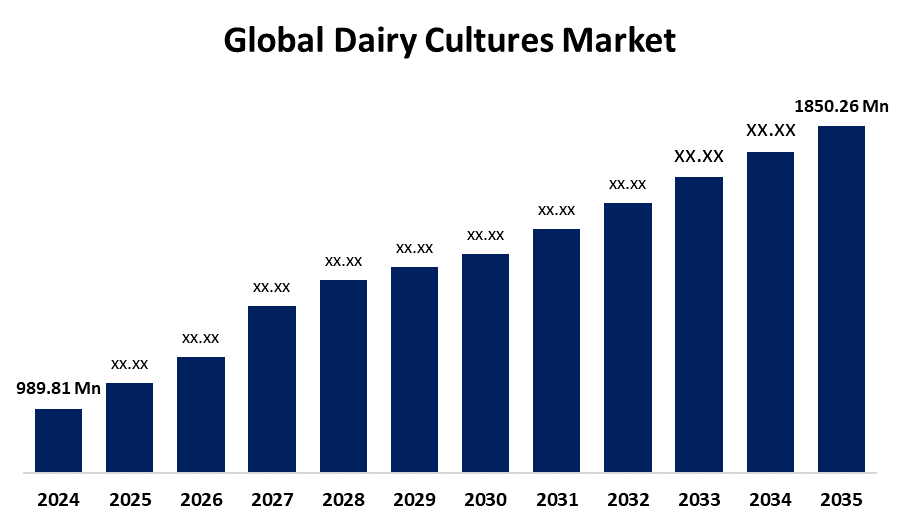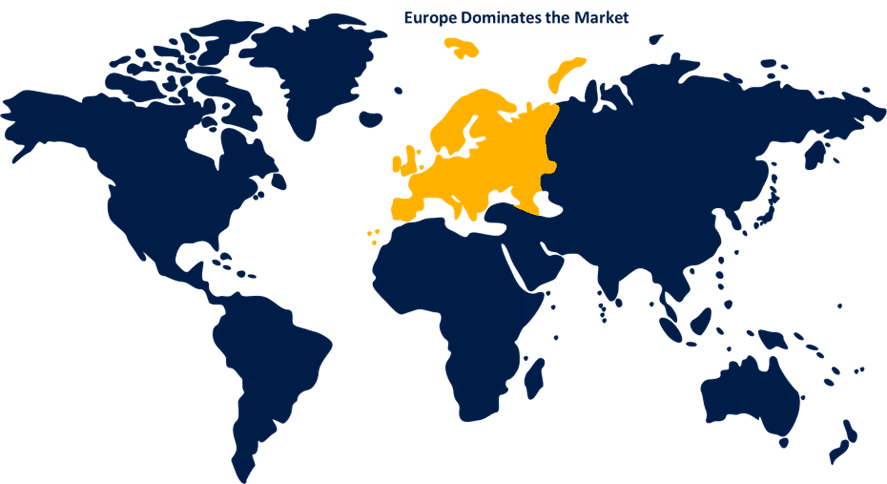Global Dairy Cultures Market Size, Share, and COVID-19 Impact Analysis, By Type (Mesophilic and Thermophilic), By Fermentation Type (Yeast-Lactic Acid, Fungus-Lactic Acid, and Lactic Acid), By End Use (Cheese, Yogurt, Kefir, and Others), and By Region (North America, Europe, Asia-Pacific, Latin America, Middle East, and Africa), Analysis and Forecast 2025 - 2035.
Industry: Food & BeveragesGlobal Dairy Cultures Market Insights Forecasts to 2035
- The Global Dairy Cultures Market Size Was Estimated at USD 989.81 Million in 2024
- The Market Size is Expected to Grow at a CAGR of around 5.85% from 2025 to 2035
- The Worldwide Dairy Cultures Market Size is Expected to Reach USD 1850.26 Million by 2035
- Asia Pacific is expected to grow the fastest during the forecast period.

Get more details on this report -
The Global Dairy Cultures Market Size was Worth around USD 989.81 Million in 2024 and is Predicted to Grow to around USD 1850.26 Million By 2035 with a compound annual Growth rate (CAGR) of 5.85% from 2025 to 2035. The rising health awareness and demand for probiotic-rich, clean-label products. Innovation and adaptability, including plant-based and functional offerings, continue to expand its global appeal.
Market Overview
The dairy cultures market refers to the industry concentrated on creating, refining, and marketing microbial cultures for use in dairy processing to start and regulate the fermentation process. Certain strains of bacteria, molds, or yeasts are purposefully added to milk or milk-based products. These cultures have a significant impact on the flavor, texture, shelf life, and nutritional profile of a variety of dairy products, including yogurt, cheese, kefir, sour cream, and buttermilk.
There is growing consumer demand for dairy products that are functional and high in probiotics. Modern dairy production relies heavily on microbial cultures because of their critical role in improving flavor, texture, and health benefits. Interest in probiotic-enhanced foods like yogurt and specialty cheeses is still growing as people become more conscious of gut health and immunity. The commercial potential is further increased by ongoing research and innovation in fermentation methods and culture strains. Dairy cultures would continue to lead the way in functional food trends as consumer preferences shift toward health and well-being. This sets up the market for long-term innovation and international growth.
Report Coverage
This research report categorizes the dairy cultures market based on various segments and regions, forecasts revenue growth, and analyzes trends in each submarket. The report analyses the key growth drivers, opportunities, and challenges influencing the dairy cultures market. Recent market developments and competitive strategies such as expansion, type launch, development, partnership, merger, and acquisition have been included to draw the competitive landscape in the market. The report strategically identifies and profiles the key market players and analyses their core competencies in each sub-segment of the dairy cultures market.
Global Dairy Cultures Market Report Coverage
| Report Coverage | Details |
|---|---|
| Base Year: | 2024 |
| Market Size in 2024: | USD 989.81 Million |
| Forecast Period: | 2025-2035 |
| Forecast Period CAGR 2025-2035 : | 5.85% |
| 2035 Value Projection: | USD 1850.26 Million |
| Historical Data for: | 2020-2023 |
| No. of Pages: | 240 |
| Tables, Charts & Figures: | 121 |
| Segments covered: | By Type, By Fermentation Type, By End Use, By Region and COVID-19 Impact Analysis |
| Companies covered:: | DSM, ADM, Alltech Inc., Balletic Inc., Cargill, Clover S.A. Proprietary Limited, Dean Foods Company, Grupo Lala, Arla Foods Amba, Amul, SanCor, Saputo Inc, Fonterra Co-operative Group Limited, and other key vendors. |
| Pitfalls & Challenges: | COVID-19 Empact, Challenge, Future, Growth, & Analysis |
Get more details on this report -
Driving Factors
There is growing consumer interest in natural nutrition, wellness, and health, which is responsible for driving the market. Probiotic-rich fermented dairy products are becoming more and more popular due to their nutritional value and digestive advantages. This trend is further supported by the move toward minimally processed and clean-label goods. Despite obstacles like supply chain interruptions, market reach is still growing through innovation and flexibility, including plant-based substitutes. Dairy products that are fortified and functional meet changing customer needs. The dairy culture market is ideally positioned for long-term growth and innovation as health consciousness rises.
Restraining Factors
The market growth is hindered by the high production costs and intricate manufacturing procedures. Dairy products may become less competitive when compared to alternatives due to these expenses. Additionally, consumers are becoming less interested in traditional dairy products due to the rising popularity of plant-based alternatives. Despite the continued need for functional foods, these factors taken together could restrict market growth.
Market Segmentation
The dairy cultures market share is classified into type, fermentation type, and end use.
- The thermophilic segment held the largest share in 2024 and is anticipated to grow at a significant CAGR during the forecast period.
Based on the type, the dairy cultures market is classified into mesophilic and thermophilic. Among these, the thermophilic segment held the largest share in 2024 and is anticipated to grow at a significant CAGR during the forecast period. The segmental growth can be attributed to its vital roles in the manufacturing of dairy products that have undergone fermentation, such as cheese and yogurt. These cultures thrive at temperatures between 40 and 45°C, which facilitates quick and effective fermentation. Important strains like Streptococcus thermophilus and Lactobacillus delbrueckii are frequently utilized to enhance flavor, texture, and shelf life while maintaining constant quality. The dairy industry's broad adoption of thermophilic cultures is being driven by the rising demand for goods like hard cheeses and Greek yogurt.
- The yeast-lactic acid segment accounted for the largest share in 2024 and is estimated to grow at a remarkable CAGR during the forecast period.
Based on the fermentation type, the dairy cultures market is categorized into yeast-lactic acid, fungus-lactic acid, and lactic acid. Among these, the yeast-lactic acid segment accounted for the largest share in 2024 and is estimated to grow at a remarkable CAGR during the forecast period. The segmental growth can be attributed to the extensive use of yeast-lactic acid fermentation in the manufacturing of cheese and yogurt, among other dairy products. The market for yeast-lactic acid cultures has increased due to consumers' growing enthusiasm for these fermented dairy products, which are spurred by their distinct flavors and health benefits. The market for this particular fermentation type has also been driven by developments in fermentation technologies and the growing demand for foods high in probiotics.
- The cheese segment held the largest share in 2024 and is anticipated to grow at a significant CAGR during the forecast period.
Based on the end use, the dairy cultures market is categorized into cheese, yogurt, kefir, and others. Among these, the cheese segment held the largest share in 2024 and is anticipated to grow at a significant CAGR during the forecast period. The segmental growth can be attributed to its wide range of culinary uses, enticing flavor profiles, and general public acceptability. Cheese is still in high demand as a basic component of many different cuisines around the world. Cheese's lasting consumer appeal and crucial significance in the food sector are reflected in its segment's continued dominance.
Regional Segment Analysis of the Dairy Cultures Market
- North America (U.S., Canada, Mexico)
- Europe (Germany, France, U.K., Italy, Spain, Rest of Europe)
- Asia-Pacific (China, Japan, India, Rest of APAC)
- South America (Brazil and the Rest of South America)
- The Middle East and Africa (UAE, South Africa, Rest of MEA)
Europe is anticipated to hold the largest share of the dairy cultures market over the predicted timeframe.

Get more details on this report -
Europe is anticipated to hold the largest share of the dairy cultures market over the predicted timeframe. The regional growth can be attributed to its substantial presence of important industry companies, large per capita dairy consumption, and longstanding dairy culture. Fermented dairy products like cheese and yogurt are produced and consumed in large quantities in nations like France, Germany, and the Netherlands. Furthermore, a strong cold chain infrastructure and strict quality standards foster innovation and market maturity.
Asia Pacific is expected to grow at a rapid CAGR in the dairy cultures market during the forecast period. The region's growth is being driven by economic growth, rising consumer demand, and technical developments. Dominance in the market is further reinforced by government assistance and an expanding middle-class population. For strategy and product positioning to be effective, it is essential to comprehend regional variations. All of these elements work together to support the dairy culture market's steady expansion.
Competitive Analysis:
The report offers the appropriate analysis of the key organizations/companies involved within the dairy cultures market, along with a comparative evaluation primarily based on their type of offering, business overviews, geographic presence, enterprise strategies, segment market share, and SWOT analysis. The report also provides an elaborative analysis focusing on the current news and developments of the companies, which includes type development, innovations, joint ventures, partnerships, mergers & acquisitions, strategic alliances, and others. This allows for the evaluation of the overall competition within the market.
List of Key Companies
- DSM
- ADM
- Alltech Inc.
- Balletic Inc.
- Cargill
- Clover S.A. Proprietary Limited
- Dean Foods Company
- Grupo Lala
- Arla Foods Amba
- Amul
- SanCor
- Saputo Inc
- Fonterra Co-operative Group Limited
- Others.
Key Target Audience
- Market Players
- Investors
- End-users
- Government Authorities
- Consulting And Research Firm
- Venture capitalists
- Value-Added Resellers (VARs)
Recent Development
- In August 2022, ADM, a global leader in sustainable nutrition, teamed up with New Culture, a biotechnology company that specializes in animal-free dairy products, to expedite product development and commercialization in the alternative dairy area. The collaboration focuses on precision fermentation to produce animal-free cheese, particularly mozzarella.
Market Segment
This study forecasts revenue at global, regional, and country levels from 2020 to 2035. Spherical Insights has segmented the dairy cultures market based on the below-mentioned segments:
Global Dairy Cultures Market, By Type
- Mesophilic
- Thermophilic
Global Dairy Cultures Market, By Fermentation Type
- Yeast-Lactic Acid
- Fungus-Lactic Acid
- Lactic Acid
Global Dairy Cultures Market, By End Use
- Cheese
- Yogurt
- Kefir
- Others
Global Dairy Cultures Market, By Regional Analysis
- North America
- US
- Canada
- Mexico
- Europe
- Germany
- UK
- France
- Italy
- Spain
- Russia
- Rest of Europe
- Asia Pacific
- China
- Japan
- India
- South Korea
- Australia
- Rest of Asia Pacific
- South America
- Brazil
- Argentina
- Rest of South America
- Middle East & Africa
- UAE
- Saudi Arabia
- Qatar
- South Africa
- Rest of the Middle East & Africa
Frequently Asked Questions (FAQ)
-
1. What is the CAGR of the dairy cultures market over the forecast period?The global dairy cultures market is projected to expand at a CAGR of 5.85% during the forecast period.
-
2. What is the market size of the dairy cultures market?The global dairy cultures market size is expected to grow from USD 989.81 Million in 2024 to USD 1850.26 Million by 2035, at a CAGR of 5.85% during the forecast period 2025-2035.
-
3. Which region holds the largest share of the dairy cultures market?Europe is anticipated to hold the largest share of the dairy cultures market over the predicted timeframe.
Need help to buy this report?